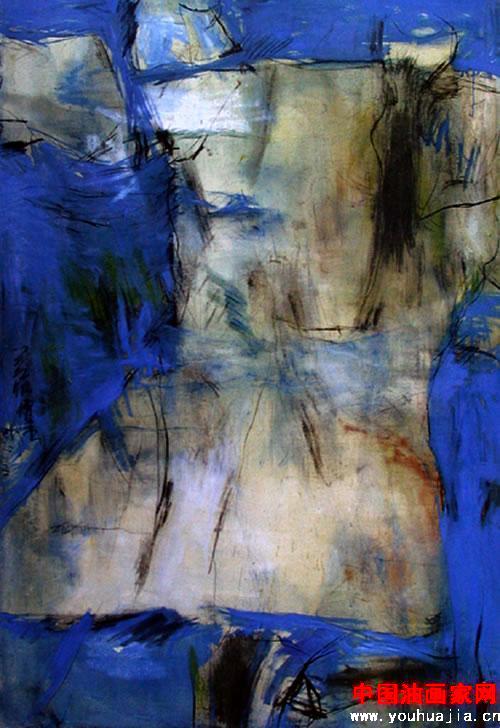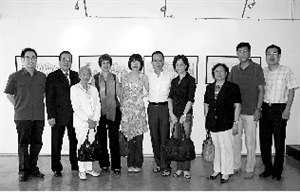澳门艺术博物馆馆长 吴卫鸣(UNG VAI MENG)
吴卫鸣出生于澳门,早年随画家甘长龄学习素描及水彩画,1992年毕业于里斯本ARCO艺术学院绘画系,1955年至今在本澳及海外的比赛中共获得五十多项艺术奬,现为澳门文化体•现代画会创会会员及澳门美协会员。1999年获任命为民署辖下澳门艺术博物馆首任馆长,2002年完成广州美术学院美术学系硕士课程。今年转任民署文康部代部长,现修读中国美术学院史论系美术学博士研究生。
艺术界普遍赞赏的是,吴氏在创作上展现出的强烈个人风格,容易让人一眼辨认出来。在绘画方面,线条里有着很强的生命力。吴卫鸣表示,“线由心生”是他在创意空间画廊举办的首次个人画展,也是继一九九八年后推出的第二次个展,涵盖过去不同的人生历程。虽然个人创作展相隔时间很长,但他坦言从来没有一刻停顿下来,一直坚持创作,就如此次展出的二十余幅素描,为近年游历世界各地所记录下来的美丽画面,不乏描绘澳门城市风貌之作,其中展出了少量现代水墨画,公诸同好,冀与广大艺术爱好者分享十年来的创作成果。
广东美术馆2007年11月19日-20日“亚洲再出发——美术馆策略与策展实践”国际学术论坛

澳门美术馆馆长吴卫鸣在发言
2008-6-11讯:吴卫鸣任民署文康部代部长
澳门日报消息,民署文康部部长晋升管委会委员后,民署近日委任原艺术博物馆馆长吴卫鸣任文化康体部代部长。吴卫鸣长年从事艺术研究,带领艺博馆开展多项大型展览和不同类型的艺术活动,开展与内地和外国博物馆机构交流与合作;出任文康部代部长后,他主要负责统筹民署文化、康体活动的工作。陈浩星长年研究中国书画艺术,在艺博馆成立后,一直协助吴卫鸣处理艺博馆工作,参与艺博馆多个展览、活动的策略和筹备工作。
##### 吴卫鸣艺术作品
···《人体风景》

···吴卫鸣美术作品集---此画集献给永远怀念的甘长龄先师
···吴卫鸣速写集:画册 出版:澳门文化学会
##### 吴卫鸣艺术活动
1、吴卫鸣个展

吴卫鸣(右五)与到贺人士在开幕礼上合照
由澳门创意空间主办的“线由心生”吴卫鸣个人画展,在该空间画廊揭幕,展出本地艺术家吴卫鸣近年游历世界各地二十多幅风景写照,线条感强。如他所言,艺术创作不追求既定且刻意的东西,只求随心所欲,自由创作,便可充分发挥创意。
文化局长何丽钻,澳门欧洲研究学会主席麦健智,以及刘羡冰、李莱德等多名社会人士出席到贺,场面热闹。
2、行为艺术
··· 吴卫鸣---追远
实施地点:上海各地点
作品分为两个阶段。
第一阶段:选定五十处售买电视、DVD的地点,如商店、商场、电视维修店、旧货店等等,播放艺术家特制的短片。这个短片约一分钟,内容是播放从大量用于祭祀的民间祖容像中抽取的不同形态的人物肖像,并于于四月四日清明节同时全日向公众(群众)播放短片。同时艺术家将到传统农村拍摄清明当日百姓于墓地拜祭先祖的情景。
第二阶段:收集于上海五十处地点拍摄得来的人们现场观察影像时的反应,再与农村拜祭的镜头和传统祖容像混合,制作五十部各长一分钟短片。在适当时机下,以五十部屏幕将按我国传统“九族五服图之秩序”形态呈现于美术馆、画廊等空间。
···吴卫鸣---《天堂 人间》
在古老的中国,传统儒家孝悌关怀及人际伦理观念是社会甚至民间日常的生活实践及价值判断的基石。而基督教关爱身边每一个人,则是天主仁爱在人间的展现与发扬。二者在中国近代发展史上有相互融合之势。中国宗族祠堂中用于个体拜祭的祖容画像同时也表达着类似宗教感的宗族集体感情。十六世纪末,随着天主教传入中国,天主教堂在各地出现(包括上海张江地区),并成为当地教友聚集祈祷的庄严场所,再次见证中西文化互容。但时至二十一世纪,在变化激烈的当代社会情境中,人际关系疏离、 家庭问题严重、道德价值混乱。作为当代人,如何能在传统文化中获得精神上的启示? 基于以上思考,我设想在张江的老天主教堂前排放一组装置,主要由玻璃叠落而成,上面丝网印制宗族人像,夜晚投射强光,营造庄严气氛。通过鲜明的形式及内在意义的对比,引发人们的思考。
Wu Weiming
Heaven, Earth
In ancient China, the traditional Confucian ethics of caring and human relations were the foundations of daily social conduct and values. Christianity, on the other hand, advocates universal love and God??s love for all of humanity. Both Confucianism and Christianity have fused in recent years in China. Chinese ancestor worship involves the worship of portraits of individuals and at the same time expresses the sentiment of religious sociality. At the end of the Sixteenth Century, along with the spread of Catholicism in China, Catholic churches appeared everywhere (including Shanghai??s Zhangjiang neighborhood), becoming the gathering and worship places of Christians and another testament to Chinese-Western interaction. But in the beginning of the Twenty-First Century, in the midst of turbulent contemporary social changes, human relations are drifting further apart, family issues growing more serious and moral values becoming unstable. How does a contemporary person receive the spiritual enlightenment of traditional culture? Based on the above thinking, I propose a set of installations at the front of the old Catholic church in Zhangjiang composed mainly of stacked glass and silk screens with images of people in the form of ancestor worship portraits. A bright light will shine onto them at night, creating a solemn atmosphere. This work will evoke reflection through the contrast between its bright form and intrinsic meaning.
3、吴卫鸣主编 澳门艺术博物馆出版 法国当代艺术---- (法)雅克琳·佩利安(Jacqueline Péglion) 安·嘉美等译
##### 吴卫鸣的文章
----------------------------
1、
吴卫鸣 民间祖容像的承传 ----收录于艺术史与艺术理论(全两册)
2、
澳门艺术博物馆海报设计展 贺词
澳门艺术博物馆海报设计展
主办:澳门艺术博物馆、广州美术学院大学城美术馆
地点: 广州美术学院大学城美术馆 5、6号展厅
展览日期:2008年3月28日至4月22日
十六世纪中叶,葡萄牙商船开始陆续在澳门靠岸,从那时起,极具特色的异国文化正式在这个南中国小城中散播开来。多年来,葡萄牙、马来西亚及日本等外来文化与本地文化经历长时间的磨合,对此间的生活习惯、饮食文化,以至日常语言等运用方面都产生了深刻的影响。同一时间,西方的科学、艺术、宗教、文化都不断通过澳门输入中国内地;中国丰富的物产乃至哲学思想等亦从澳门传往欧洲。中西文化交流,在澳门拉开了序幕。
但到了十九世纪中叶鸦片战争后,澳门的国际贸易港地位逐渐被香港取代,文化中转站的角色从此淡出。但是,澳门并未因而终止了自身文化的滋长。一九一零年,澳门成立了第一所博物院──贾梅士博物院,亦即是澳门艺术博物馆前身。到了三十年代,该馆在社会热心人士的关怀下取得了很大的发展,其艺术藏品亦日益丰富。在七十年代,馆方以拓阔本地艺术家的视野为目标,除了展出自身收藏,还开设画廊,并积极邀请外来及本地艺术家举办展览,以期建立起艺术交流的平台,使艺术家在观摩及学习中不断成长。
一九九九年,即澳门回归祖国怀抱同一年的三月十九日,澳门艺术博物馆正式对外开放。这是一个崭新的文化设施空间及举办大型展览的重要场地,从开馆至今举办了逾百项各类型展览及活动。这些项目的合作者包括北京故宫博物院、上海博物馆、南京博物院、河南省博物馆等内地大型文博机构、及来自香港、台湾、法国、葡萄牙、意大利、捷克、芬兰、西班牙、美国、墨西哥、哥伦比亚、埃及、新西兰等国家、地区的博物馆及艺术家、收藏家等,这些展览中既有清代皇家收藏的珍贵文物,也有如陈淳、徐渭、董其昌、八大、石涛,扬州八怪或近代的吴昌硕、张大千、傅抱石等代表中国传统文化精萃的作品,而西方艺坛举足轻重的毕加索、米罗、雷诺阿、尼基、克莱茵、阿曼等重要艺术家的作品也曾在此展出。在中西文化交流的舞台上,澳门艺术博物馆扮演着一个重要的角色。
一个展览活动的成功与否,除本身的素质外,宣传形象的确立也极为重要,宣传海报的设计是否突显每一项目的特性?出版物能否吸引大众的视线且引起广泛关注?这些都是主办机构的重要考虑内容。我馆拥有由一群青年设计师组成的精干团队,他们因应不同的项目,以艺术及文化的角度出发,尝试打破常规,以期取得独特的效果。在画面上,从用色、字体配合以至版面设计上的变化,都力求从原本传统刻板的内容中引发出现代感的视觉元素。作为一个多元文化汇聚的小城,我馆在海报创作上不能避免地面对着不同种族的语种问题,如中文、葡萄牙文及英文甚至法文、西班牙文、意大利文等,常常需要同时出现在同一张海报上。然而,通过别出心裁的安排,此等限制却反而成为艺博馆在设计上的一大特色。二零零四年本馆受芬兰拉特海报博物馆及赫尔辛基海报美术馆的邀请展出本馆部分海报创作。二零零六年至二零零七年间,我馆创作的多款海报先后在捷克布尔诺“第二十二届平面设计双年展”主展场及皮尔森吉瑞.特兰卡展览馆展出。
今天,澳门民政总署辖下澳门艺术博物馆十分荣幸与广州美术学院大学城美术馆合作,向广州市民介绍这些宣传海报,这里展出的一百幅作品,大部分出自本馆平面设计师之手,借着这些风格各异的海报,观众不但可以欣赏到设计师们的独特艺术创作,也可以与我们一起分享并重温澳门艺术博物馆开幕至今所举办的精彩展览及活动,见证本馆的成长之路。
吴卫鸣
澳门艺术博物馆馆长
In the middle of the 16th Century, Portuguese merchant ships started to anchor off Macao. Since that time, an exotic culture has taken root in this tiny southern Chinese city. Over the years, foreign cultures - Portuguese, Malaysian and Japanese to name but a few - have coalesced with each other, profoundly influencing the lifestyle, diet and even daily use of language in the city. At the same time, Western science, art, religion and culture have been imported to China via Macao, while rich Chinese products and even philosophical concepts have travelled to Europe from the city. The cultural exchange between East and West largely has its origins in Macao.
Following the Opium War in the mid-19th Century, Macao was overtaken by Hong Kong as an international trade port. Consequently, the city started to withdraw from its role as a centre of ‘cultural transfer’. Nevertheless, local culture has not stopped developing. The Luis de Cam?es Museum – the first in the city and a predecessor to the Macao Museum of Art - was founded in 1910. In the 1930s, the museum developed significantly thanks to the devotion of various passionately enthusiastic individuals in local society. The collections acquired increased at a steady rate and in the 1970s the museum sought to broaden the exposure of local artists by founding a gallery in addition to displaying collections. The museum has also encouraged foreign and local artists to hold exhibitions in order to build a strong base for exchange between artists, providing rooms for them to continuously improve by viewing and learning from each other’s works.
On 19th March 1999, the year that Macao was returned to China, the Macao Museum of Art officially opened its doors to the public - a brand new cultural facility and an important venue for large exhibitions – since when it has hosted over 100 various exhibitions and activities. Event collaboration has involved many leading art museums from Mainland China such as the Palace Museum in Beijing, Shanghai Museum, Nanjing Museum and Henan Provincial Museum as well as museums, artists and collectors from Hong Kong, Taiwan, France, Portugal, Italy, the Czech Republic, Finland, Spain, U.S.A., Mexico, Columbia, Egypt and New Zealand. Exhibits include precious relics from the Imperial Court of the Qing Dynasty and masterpieces representing the very essence of Chinese tradition and culture, such as the works of Chen Chun, Xu Wei, Dong Qichang, Ba Da, Shi Tao and the Eight Eccentric Painters of Yangzhou plus Wu Changshuo, Zhang Daqian and Fu Baoshi in more recent times. In addition, MAM has exhibited masterworks by prominent artists such as Pablo Picasso, a giant in the lexicon of Western art, Joan Miro, Pierre-Auguste Renoir, Niki de Saint Phalle, Yves Klein and Arman. As such, Macao Museum of Art is playing an important role in cultural exchange between East and West.
Apart from quality, the success of an exhibition depends on the image it is projecting and whether the design of the promotional poster highlights the features of the event or publications attract readers whose attention and interest is sufficiently aroused. These are important considerations for organisers. We have an excellent team of young designers who create posters for all events with great artistic flair and who constantly strive to free themselves from convention in order to create a unique impact. They strive to introduce modern visual elements into traditional, formulaic content by employing variations in such elements as colour and font style and size.
Macao is a city of various integrated cultures and it is therefore inevitable that we sometimes face problems concerning the language of different ethnic groups when designing our posters. For example, Chinese, Portuguese, English and even French, Spanish and Italian

 会员区*发表文章
会员区*发表文章
 设为首页
设为首页
 繁体中文
繁体中文
 用户登录
用户登录
 我要投稿
我要投稿

 会员区*发表文章
会员区*发表文章
 设为首页
设为首页
 繁体中文
繁体中文
 用户登录
用户登录
 我要投稿
我要投稿
 您现在的位置: 吴氏网 >> 资讯 >> 文籍 >> 人物 >> 正文
您现在的位置: 吴氏网 >> 资讯 >> 文籍 >> 人物 >> 正文